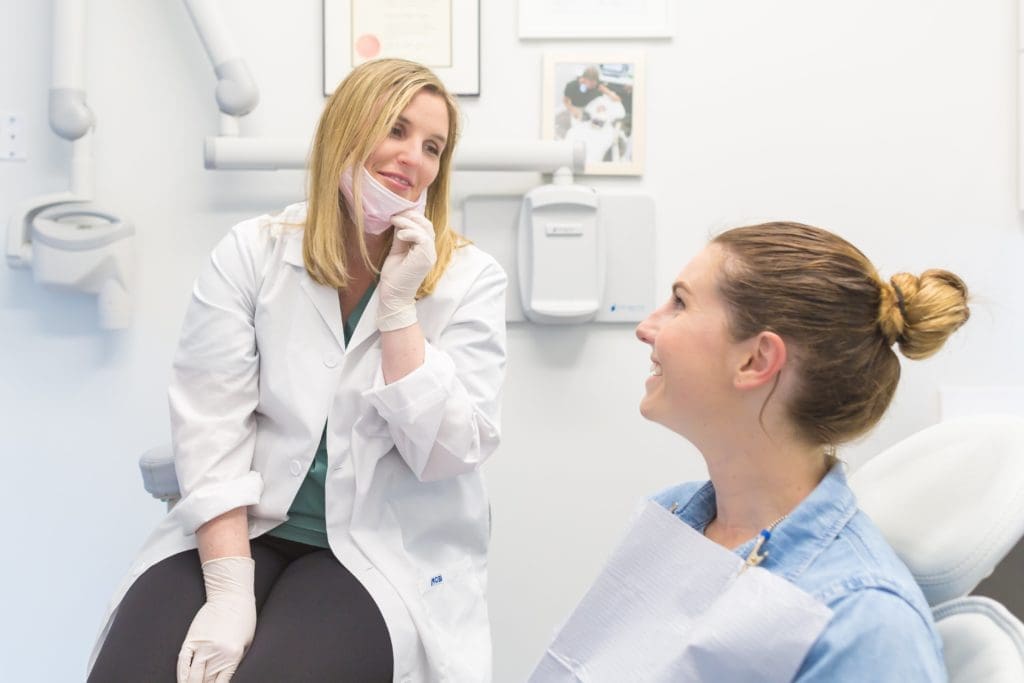Last updated on July 12th, 2023 at 12:46 pm
 The quality of customer service—or lack thereof—can make or break the success of a dental practice. You could be on top when it comes to clinical competence, a well-intentioned staff or marketing excellence and still have patients that don’t want to come in the face of a subpar customer service experience.
The quality of customer service—or lack thereof—can make or break the success of a dental practice. You could be on top when it comes to clinical competence, a well-intentioned staff or marketing excellence and still have patients that don’t want to come in the face of a subpar customer service experience.
We actually have an entire FREE e-book dedicated to improving customer service. It has a 28 pages filled with a lot of information. You can download it by clicking here
Waiting too long, feeling ignored or rushed around, being treated like a nuisance instead of welcomed as a happy guest…these are all things add up to a patient having a bad experience and not wanting to come back for their next appointment—or worse, leaving a negative review on Google or Yelp.
Conversely, excellent customer service that makes a patient feel valued and cared for is a vital ingredient in the recipe for patient retention and comprehensive treatment acceptance – and of course referrals!
That said, superlative customer service is built on just a few simple factors.
We’ve touched on a number of these in previous MGE blog posts, but in this post, I want to tie everything together in one spot; a complete outline of the most important aspects of customer service.
 I recommend that you review this with your staff and then get your heads together to figure out how you can use all of these points to improve customer service in your office. Also, the MGE New Patient Workshop is an excellent workshop chock full of information that will help you get more high-quality new patients, retain them and wow them with a one-of-a-kind new patient experience.
I recommend that you review this with your staff and then get your heads together to figure out how you can use all of these points to improve customer service in your office. Also, the MGE New Patient Workshop is an excellent workshop chock full of information that will help you get more high-quality new patients, retain them and wow them with a one-of-a-kind new patient experience.
Before I get started, though, there are two quick points I want to make about the subject of customer service:
1) The patient is the most important thing in your practice. They are the entire reason your practice exists. They should be treated as such. Value their time. Give them kindness, respect, and generally make them feel important.
HOWEVER, dentistry (or healthcare in general) is considerably different than other business models, like a retail store or company that sells a boat, car, equipment, etc. – in that the customer is NOT always right.
Of course you would never be rude or argue with the patient, but you must keep in mind that you are dealing with health matters here, not whether or not they wish to buy a luxury item. They are not as educated as the doctor when it comes to making decisions about their oral health—and often they may be held back by a fear of needles or drills. So you might not simply accept whatever they say as “the customer is always right and we must give them what they want.” You’ll have to be patient with them, explain the treatment plan thoroughly and so on until they reach a level of understanding where they will make the best decision for their health.
2) Don’t focus on the negatives. You must maintain a positive atmosphere in the office for both the staff and patients—even when things go wrong. Of course it’s not always a perfect day at the office. Things happen. These things must be addressed and handled, but not focused on as a team. Don’t dwell on them.
When everybody is thinking, “Oh no the schedule fell apart again, we’re screwed…” or “The doctor or OM are mad…” the patient can feel that when they come in. Address the problems, move on, and keep a positive atmosphere. When the patient comes in, they should be thinking, “Wow, they’re so happy to see me! I love coming here.”
(Related: 3 Techniques to Improve Employee Phone Skills)
The Components of Good Customer Service
Have Good Manners
What is considered proper manners or not depends on the region you are in. In some areas it is proper to use “Sir,” “Ma’am,” “Mr.______” “Ms.____,” etc. In other areas that might seem out of place. An office in Key West, FL may be more casual than an office in Washington, D.C. So, be appropriate for you area, but no matter where you are, be sure to follow these general guidelines:
- Be polite and respectful
- Make the patient feel important—because they are! Don’t treat them like they’re a hassle in your already busy day.
- Greet the patient as soon as they enter the practice. They shouldn’t have to stand at the desk and wait for the front desk person to have a moment for them. They should be welcomed immediately as expected guests that you’re happy to have in the office.
- Address the person by name. Keep in mind; this would be their first name, not their last name (in any event, always ensure you stay in compliance with HIPAA and check the law itself if you have questions).
Be Observant & Interested in the Patient
 You should never wait for the patient to bring up an issue, problem or disagreement that they are having. In fact, if they voice it on their own, that’s actually an error on our part for not recognizing and addressing it soon.
You should never wait for the patient to bring up an issue, problem or disagreement that they are having. In fact, if they voice it on their own, that’s actually an error on our part for not recognizing and addressing it soon.
And I don’t mean that you should be psychic and use intuition to know what concerns the patient might or might not be thinking of.
What I do mean is that you should be observant and have good communication with the patient. Sometimes this is simple: “She looks like she has tears in her eyes, is everything okay?” “This patient hasn’t said anything for a while, I should see if they have some concern or question.”
(Related: New Patients: How Not to Ruin Their First Impression)
Let them know early on that if there is any point where they feel overwhelmed, uncomfortable, have any questions or feel like they’re having a hard time getting through the procedure…call you over so you can help them out. Keep an eye on the patient and if they seem like they have their attention on anything, find out what it is and how you can help them with it.
This kind of personal interest and care is the whole crux of good customer service. And I promise you, this will impress a patient much more than hi-tech gadgets, big screen TVs, fresh squeezed orange juice or spa services.
And keep in mind: when you discover an issue that a patient might have with your office – that is NOT a problem. The problem is when you discover something like this and DON’T fix it!
Keep Them Informed at All Times
What you want to avoid here is the patient feeling disoriented, like they’re being rushed around the practice and they don’t know why or what’s next.
You need to keep them oriented and informed every step of the way. This starts as soon as you they enter the practice.
- When patients arrive at the front desk, let them know how long of a wait it will be. (Hopefully it won’t be any wait at all)!
- Give new patients a tour of the office before they are seated in the operatory. Dr. Leslie Pasco describes how and why you should do this in her blog post, The New Patient Tour.
- Explain what’s happening next. Let the patient know, “Now we’ll do an x-ray, it’ll just take a few minutes.” “Jessica will be doing your cleaning and then Dr. Smith will come in to do your exam.”
- Do a proper “hand-off,” meaning that you introduce the patient to the next person they see and make sure the staff member is up-to-date on what is needed. A properly executed “hand-off” is outlined in our blog post, The Hand-Off, Don’t Drop the Ball.
Don’t Make Them Wait
I’ve known many doctors who consider it perfectly normal to be running twenty or thirty minutes behind—or more. It can be easy to find yourself running through lunch and past dinner time. This is a bigger problem than you realize.
People really hate waiting. Think of the last time you went to the DMV or waited in an airport security line. It’s unpleasant and ruins your experience faster than anything else. And beyond that, it’s sends a very clear message that your time is more important than theirs.
It may be unfair, but no matter how nice you are or how justified you are in running behind, in the patients mind you don’t really care about them and aren’t giving them good service if you make them wait. It sabotages all other efforts you make to build good relationships with your patients.
Take a look at Dr. Ken Cirka’s article The 10 Minute Rule…Don’t Make Your Patients Wait to see how he makes his rule that patients never wait more than 10 minutes a reality.
Keep the Office Clean & Organized
Obviously the clinical areas need to be hygienic. Other areas can easily get a little messy without us noticing. How’s the signage outside? The front door? The waiting area? The receptionists desk? The restrooms?
Take a look at all of these areas with fresh eyes. Over time little messes can build up without noticing. A stack of papers or a box in the corner can be there for so long that it just kind of becomes “part of the scenery” and your eyes just slide over them without noticing. But if you use fresh eyes and look at every area of the practice as if you were a patient seeing it for the first time, you’ll probably notice that there are little things here and there give a poor first impression. The video below describes this:
It’s the responsibility of everybody in the office to, first, make sure that their personal areas are straight and clean, and second, make sure that any common areas that patients see are kept tidy as well. This doesn’t mean that you all need to be janitors, but if you see something messy, make sure it gets straightened up so you give a good impression to patients.
This also goes for the dress of the staff. Have a dress code and make sure it’s followed. I won’t tell you exactly what that dress code should be—again, the dress code in Key West, FL might be different than the dress code in downtown Manhattan, NY. Many offices wear scrubs, while other have collared shirts. Whatever it is, make sure it’s professional and consistent.
(Related: One Incredibly Simple Change to Make Your Front Desk More Efficient)
Be Direct & Honest with the Patient
People like it when you’re direct with them. If you’re running 15 minutes behind, let them know. If they need extensive treatment, let them know—even if you’re worried the price will be too high for them. Trying to sugar coat things too much can often lead to people feeling misled or lied to, which causes more problems. Better to just be honest and deal with any fallout then instead of having a bigger upset later because they felt like they were lied to.
Be Prompt & Accurate with Billing
By survey, they two biggest complaints are waiting too long and billing mistakes. If you really want to upset someone, charge them for the wrong thing or send them the wrong bill. Money is a highly charged subject, and on the receiving end it’s infuriating to see a charge for something that’s higher than what was agreed upon—because now you need to go out of your way to sort something out that wasn’t your fault in the first place.
Yelp and Google are filled with negative reviews from people who got overcharged or billed incorrectly. So great care should be taken to bill and charge the correct amount in a timely fashion.
(Related: Why the Customer Isn’t Always Right)
Keep Drama Away from Patients (& Out of the Office Entirely)
If there is ever a disagreement or difference of opinion, it must never be sorted out in front of the patient. Of course staff should always be professional and courteous with each other regardless of the presence of patients, but even still any disagreements should be sorted out in private. This also goes for personal calls or upsets. This goes a long way in promoting a positive atmosphere in the office.
Provide an Outlet for Happy Patients to Express Their Gratitude
When any of us are very happy or thankful for something, we like to express that and be acknowledged. It’s a human trait. If we aren’t able to express our thanks, it puts a damper on things and makes us feel like something is missing.
So provide a way for patients who have had life-changing treatment or simply a great experience in the office to express this. It may be as simple as having a pen and paper ready for patients to write their “success stories” and letting them know you’ll share it with the staff. Or encourage them to leave a positive review on Yelp or Google. Video testimonials are a great idea, too—you can record them with a smart phone and put them on YouTube and your website. Also give them a referral card to give to their friends and family (more info on the referral program here).
Present & Perform Full Treatment Plans
If you go to Starbucks wanting a grande coffee, but you walk out with only a quarter of a cup filled, you’d think that’s pretty poor service, right?
Well, it’s a similar situation if a person needs four crowns and they walk out with only one. Perhaps the rest are planned for future years when insurance benefits kick in or not. The point is, they’re not getting the full service that they need, and they’re still not healthy from a dental perspective.
This can be a tough one, because the patient may have financial concerns, dental fears, or any other reason not to do treatment. But I call your attention to what I said earlier about the customer not always being right in dentistry. They aren’t educated and it’s your job to present the treatment plan in a way that they can understand it fully and make the best choice for their health. Usually this means accepting the entire treatment plan and not a phased or partial treatment plan.
We have a lot of tips you can use to improve case acceptance on the MGE YouTube Channel. Watch our playlist on case acceptance here:
So it’s really on you to make sure they consent to receiving the full extent of the service. This also brings me to my next point…
(Related: Try This in Your Practice: Lunch and Learn with Your Staff)
Have Financing Options Available
If you’re going to insist that patients make the right choice regarding their treatment plan, you also need to do everything you can to make it easy for them. So have financing and payment options that make it as easy and stress-free as possible for patients to pay for treatment now—not months or years later.
Summary
Go through these points with your staff and get their input, too. Figure out how you can use this to improve customer service in your office. I think it’ll make a big difference in patient loyalty, production, and new patient referrals if you do.
And if you’d like help getting more organized and efficient, that’s what we’re here for! Give us a call anytime at (800) 640-1140 or attend the MGE New Patient Workshop to really master the new patient experience, get more new patient referrals and more high-quality new patients. And again, we have a free e-book filled with information about how you can improve customer service in your dental office. You can download it by filling out the form below:
Customer Service eBook:



Great tips as always
our office is one in a million we treat all pt with due respect and make them feel confortable we are kind and fill all the pt needs
very helpful tips
VERY HELPFUL POINTS